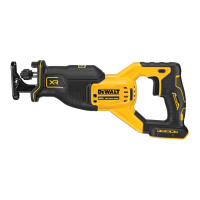ENGLISH
10
Cleaning
WARNING: Blow dirt and dust out of all air vents with
clean, dry air at least once a week. To minimize the risk
of eye injury, always wear ANSI Z87.1approved eye
protection when performingthisprocedure.
WARNING: Never use solvents or other harsh
chemicals for cleaning the non‑metallic parts of
the tool. These chemicals may weaken the plastic
materials used in these parts. Use a cloth dampened
only with water and mild soap. Never let any liquid
get inside the tool; never immerse any part of the tool
into aliquid.
MAINTENANCE
WARNING: To reduce the risk of serious personal
injury, turn unit off and remove the battery pack
before making any adjustments or removing/
installing attachments or accessories. An
accidental start‑up can causeinjury.
Pocket Cutting - Wood Only (Fig. K)
Measure the surface area to be cut and mark clearly with a
pencil, chalk orscriber.
1. Insert blade in blade clamp and tighten blade
clampsecurely.
2. Tip the saw backward until the back edge of the
pivoting shoe is firmly on the worksurface.
3. Switch motor on, permitting blade to attain
maximumspeed.
4. Grip handle steadily and begin a slow, deliberate
upward swing with the handle of thesaw.
5. The blade will begin to feed into material. Always
be sure blade is completely through material before
continuing with pocketcut.
NOTE: In areas where blade visibility is limited, use the
edge of the pivoting shoe as aguide.
Project Tips
• Cut only with sharp blades; they cut cleaner, faster and put
less strain on the motor whilecutting.
• When cutting, always ensure that the pivoting shoe
is resting against the workpiece. This will improve
operator control and minimizevibration.
• For longer blade life, use bi-metal blades or carbide
tipped blades. These utilize a carbon steel back welded
to high speed steel teeth making the blade more
flexible and less prone tobreaking.
Cutting (Fig. A, F)
WARNING: Always use eye protection. All users
and bystanders must wear eye protection that
conforms to ANSI Z87.1.
WARNING: Exercise extra caution when cutting
towards operator. Always hold saw firmly with both
hands while cutting.
The blade
10
should extend past the pivoting shoe
4
and
the thickness of the workpiece throughout the cut. Select
the blade best suitable for the material to be cut and use
the shortest blade suitable for the thickness of the material.
Do not use jigsaw blades with thistool.
NOTE: Before cutting any type of material, be sure it is firmly
anchored or clamped to preventslipping.
• Place blade
10
and pivoting shoe
4
lightly against work
to becut.
• Switch on saw motor and allow it to obtain maximum
speed before applyingpressure.
• Always hold saw firmly with both hands while cutting as
shown in Figure F. Whenever possible, the pivoting shoe
must be held firmly against the material being cut. This
will prevent the saw from jumping or vibrating and will
minimize bladebreakage.
Flush Cutting (Fig. H)
The compact design of the recipro cating saw motor
housing and pivoting shoe permit close cutting to floors,
corners and other difficultareas.
1. To maximize flush cutting capabilities, insert the blade
shaft into the blade clamp with the teeth of the blade
facingup.
2. Turn the saw upside down so you are as close to the
work surface aspossible.
Wood Cutting (Fig. I)
1. Before cutting any type of wood, be sure the workpiece
is firmly anchored or clamped to preventslipping.
2. Place blade and pivoting shoe firmly against work
tobecut.
3. Switch on saw motor before starting thecut.
4. Always hold saw firmly with both hands while cutting.
Whenever possible, the pivoting shoe must be held
firmly against the material being cut. This will prevent
the saw from jumping or vibrating and minimize
bladebreakage.
Metal Cutting (Fig. J)
1. Use a fine tooth blade for ferrous metals and a coarse
tooth blade for non-ferrousmaterials.
2. In thin gauge sheet metals it is best to clamp wood to
the underside of the sheet. This will ensure a clean cut
without excess vibration or tearing ofmetal.
3. Avoid forcing cutting blade as this reduces blade life
and causes costly bladebreakage.
NOTE: You should spread a thin film of oil or other coolant
along the line ahead of the saw cut for easier operation
and longer blade life. For cutting aluminum, kerosene
ispreferred.
Accessories
WARNING: Since accessories, other than those
offered by DeWALT, have not been tested with this
product, use of such accessories with this tool could be
hazardous. To reduce the risk of injury, only DeWALT
recommended accessories should be used with
thisproduct.
Recommended accessories for use with your tool are
available at extra cost from your local dealer or authorized
service center. If you need assistance in locating any

